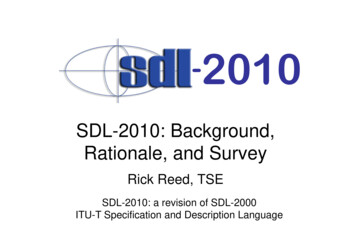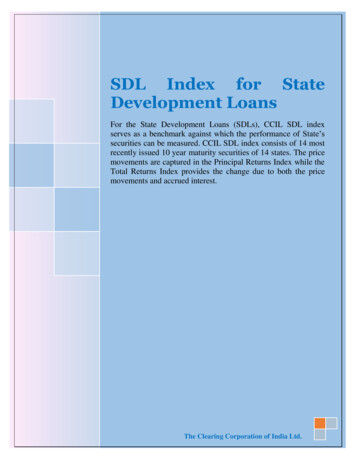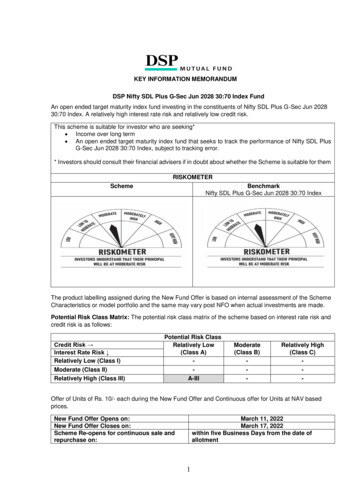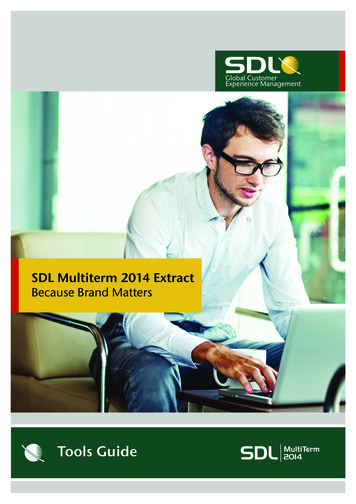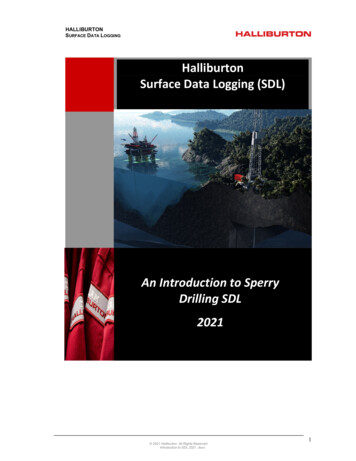
Transcription
ATheoreticalOFandInducedDamageEffectsof2GrantCo 60MOSSTRUCTURESNs6-588ExperimentalStudiesto iceof e
SsilicontheoftypeonSiO 2WALTERwereeffectshadmeasuringofMOSstructures.Co .6at1011cm-2eVanddensityCo onthatCo xthe-Ielevatedcanbewas106oxidebyantem-
5effectinthechargechange.initialxoxidel dmodeltobasedexplaincharge1012uponthedensitycm -2thenotedtoComptonoxide
2.INTRODUCTIONREVIEW.OF.THE4.5. . 5 8 5.9.5. i0. 7.OhnicMountingandStorageof ctionMaterialsGate .CAPACITOR5.2.5.3.5.4.5.5 .53.2.3.3.MOS DeviceStructure,BandDiagram,EquivalentCircuit.5 1.6.CALCULATION3 i citors.58606364706 i rcuittheData.7Oandthe7O
ivTABLE OF CONTENTS acitanceAutomaticDataAcquisitionAccuracyof sultsfor87OXIDEChargeModelOF12 uction.RadiationEffectson AnnealedA ensityDeterminationan n.Technique.Study.165166168171171172
VLISTOFTABLESPage7.1.8.1.8.2.8.3.9 type.for96132n-type148
or a p-typesubstratewithan appliedvoltage,V .i0The basicMOS nce.16(Source:Surfaceequivalentcircuits(a) for surfaceinversionand(b) for 964),p. 83)Atypicala p-typeoperationTypical. .capacitance-biasvoltagecurvefordevicewiththe threemodesofshown.182Ocurves--showingthe generalshapeofas a functionof appliedbiasand(b) dVsc/d sas a functionofpotential.(a) dVsc/d svoltage,surface3.74.14.24.3Atypicalcurveas a ofinsurfacesurfacethedQ ,p(x ,statedensity,potential, s26!Nss,.28gate,dQ ,andin thedueto a arbitrarychargein the agecurvesillustratingthe effectsof elevatedtemperatureannealingwithan appliedbiasvoltage.(i) Originalcurve.(2) Curveaftera 5 minuteannealat 150ocwith i0v applied.(3) Curveafter5 minutesat 150ocwithgateshort-circuitedto substrate(Source:Snowet al.(1965),p. 1666) .36Hypothesisedchargedistributionfor a orrespondingto curve(i) of Figure4.2is shownin (a) whilethe distributioncorresponding to curve(2) of Figure4.2 is shownin (b) andthe distributioncorrespondingto curve(3) ofFigure4.2is shownin (c)(Source:Snowet al.(1965),p. 1667 ) .37
urce:p.1670).4.5andnearthetheSnowe tta l. (1965),40Normalizedexcesschargeinduceda functionofthesquarerootSnowet temperaturesin a ointA(b).Diagramof equipmentusedin formingbeaminterfacepatterns(Source:(1965),p.197) ctricmetal-of tance-bias.device.77voltage79
ixLIST OF FIGURES (Continued)Page6.5A typicalcapacitance-biasvoltagecurvefor an n-type device obtainedby meansof the x-y recorder.8O6.6Measured accumulationregime capacitanceversusmeasurement frequencyfor a typicaldevice .847.1Capacitance-biasvoltagecurves for a typicaln-type device:curve (i) was taken priortoannealing;curve (2) was taken aftera 12 hour,75Oc anneal with -5.0 volt bias applied;curve(3) was taken after a 1 hour, 75oc anneal with 5.0 volt bias applied;curve (4) was takenaftera 4 hour, 75oc anneal with a -5.0 voltbias applied.89Capacitance-biasvoltagecurves for an n-typedevice:curve (i) was taken aftera 1 hour,100Oc, -5.0 volt anneal; curves (2) through(5) were each taken aftera 5 minute,100oc, 5.0 voltanneal.92Capacitance-biasvoltagecurves for an n-typedevice:curve (1) was taken aftera 100oc,negativebias anneal and is in the negativesaturationposition;curve (2) is in theintermediatepositionresultingaftera 100 C,open-circuitanneal.947.4A typicalp-type987.5MOS device diagrams showing the device coupledto the externalwafer in (a) and a decoupleddevice in (b).7.27.37.6curve for aregimes shown . .99Capacitance-biasvoltagecurves for a typicalp-type device:curve (i) was taken before anyannealingwhile curve(2) vice with the esfora typicalp-typedeviceshowingtheeffectof aturationafterapositionwhilecurve(2) wastaken75 C,positivebiasanneal.102
xLIST OF FIGURES (Continued)Page7.8Capacitance-biasvoltagecurves for a p-typedevice:curve (i) is in the negativesaturationpositionwhile curve(2) e14-33:minute,Oxidechargeshiftas eshiftasadetermined107forn-type(i)isin shownin109asii0.62 C, egative(2) 62 ltageof50 typedevice,number14-33:curve(i)isin (6)wereeachtakenaftera 3 hour,50oc, 3.0voltbiasanneal.114as.115Oxidechargetransferasa functionofthesquarerootof annealingtimefor50 C,62oc,and75oc, mber14-33:curve(i)isin thesaturationpositionwhilecurves(5) weretakenafteronei0 ran n-typedevice:curve(i)is in thenegativesaturationpositionwhilecurve(2) wastakenaftera 5 minute,75oc, 3.0voltannealnegativesaturation(2)through(5) were5 minute,75Oc, 3.07.11open7.14" .
sof Figure7.16asa functionof eforsodiumin enumberCapacitance-biasdevicenumbera givenin ityversussurfaceincreasinggammairradiation14-43as givenin Table8.2of. curvesdevicenumber14-25withgammaa parameteras givenin rves14-15withgammaas givenin rgyofCanada,Ltd.,.towardmorenegativeradiationas given4%flux118135devicea.136
xiiLIST OF FIGURES urves for p-typedevice number 36-43 with gamma irradiationas a parameteras given in Table 8.3 .1388.12 Normalizedreciprocaltransitionregion slopeof device curves shown in Figure 8.2 as afunctionof gamma exposure time.1408.13 Normalizedreciprocaltransitionregion slopeof device curves shown in Figure 8.4 as afunctionof gamma exposure on slopeof device curves shown in Figures8.6, 8.7,and 8.8 as a functionof gamma exposure time. .142Normalizedreciprocaltransitionregion slopeof device curves shown in Figures8.9, 8.10,and 8.11 as a functionof gamma exposure time143Negative saturationcapacitance-biasvoltagecurves:curve (i) was taken priorto irradiationwhile curves (2) through(i0) were taken afterirradiationperiods as shown in Table 9.1.147Semiconductorcharge change and device curvevoltageshiftas a functionof gammairradiationtime for small times .149Semiconductorcharge change and device curvevoltageshiftas a functionof gammairradiationtime for large times .150Diagram showing energies at which each of theprincipalgamma ray processes become dominant(Source: Evans (1955), p. 712) .1569.5Diagram.1579.6Band diagram of the MOS structurewithin the negativesaturationconditionthe oxide.1589.7.Diagram of hole-electronCompton effectin the9.19.29.39.4"Capacitance-biasvoltagecurves for p-typedevice number 36-42 with gamma irradiationas a parameteras given in Table 8.3 .of theCompton effectpairoxideinsilicongeneration.by the160
ationtheMOScapacitorandparambehaviorhasbeen
ateDraindefusedOhmiccontactmadeto typicalMOStransistorStructure
used as a toolforsuch study.MOS configuration)sourceand drainItitorisiscontactimpossiblewithoutthatdue to brokencussedby Atallationa layerin theinorinof f thisthisdeviceeitherdielectricisonstronglyatom bonds as dis-thisand concentraof greatimpor-chargepolarityinvolvecapac-of metal-to-semiconductorat lengthand distributionare alsotransistor.involveionseven the purestwhichwaterSinceoxidegrowthstrongin Chaptersare commonly foundofact31.0 microna chargeof 1012 cm-2 has a chargeby Snow etin thetemperatureoperaforinany impuritiessuchto some extentinin thein thicknesscontaminational.locatedtechniquesas impuritiesof the orderI.O ppm as reportedfactorsat a highor steam atmospherewillof chargefabricationAn oxidetelysurfaceThese methodsbe discussedpolaritya wet oxygenas alkalito be expectedthesis.The amount,iniswherebyas a functionand willand 4 of thisat theof the MOS transistor.are determinable.measurementsto be locatedare factorsMethods have been devisedand magnitudeor capac-The Thiswiththefabrication.semiconductoret al.of the chargetancedelieteda "clean"(havingthe MOS transistorinterface.p-typecapacitorto fabricatecausingoxide-semiconductorthe basissimplyThis(1965).oxide.containingof approximaIfan oxide
4isgrown in a dryhydrogenionsoxygen(protons)atmospherewillbe presentmethod of determiningoxidebeen devisedbe discussedand willne purposeofthe oxideofthischarge,to oxideThetemperatures.duesiliconisbyvariouson thechargesadensity.studiesthesteamand post-capacitorsDevice4.the naturethe prestateMOSAin Chapterto ureoxideoutoxide.and change hasin stemperaturesin theof such the effectThese studieschargeto determineCo60 gamma irradiationat elevatedtothatitsathetheoriginalbiaspotential.
2.LITERATURE REVIEW2.1The existencematerialsof surfacewas bornment performedconfigurationby Shockleywhichas a functionchargestatesout of the now classicand Pearsonused by theseMOS transistorsurface.Non ).appliedthatsurfacenormalsummed up ratherexperi-The experimentalwas basicallythem to monitorof an electricKingstonon semiconductorof anconductanceto thatthoroughlythe workdone on germanium up to 1955.The dependence of the capacitanceupon biaswas notedAtalliaet al.growinga surface(1959)dielectriccarriedon theobservablecapacitorawl. (1963),developedpassivationgrown oxideoutby Brown et al.was feasible.capacitance-biasby Lehovecet al.Lehovec(1963),The 4)(1961),Termanand Lehovecof silicondevelopeduntilfora thermallystudieswereexperimentallyof the MOS(1962),Lehovecand Slobodskoyet(1964).insulated-gate-field-MOS studiesthe work of Rose (1963).experimentalthatand Heiman (1963)a physicalwas nottechniqueof therelationssiliconitPreliminaryvoltageof thebuton silicondependenceby Hofsteinmarked the beginning(1956)an effectiveoxidefrequencyof the MOS structureon a largemodel forZainingerwork on the determinationessentiallyscale.the MOS diode(1964)of siliconcarriedby
6surfacestatedensitythe depletionwithrespectand accumulationto f the capacitance-biasregioncon MOS diodeequivalentdidand foundcircuitnot explainof theHofsteinthatproposedtheby storder,forthethussili-one dimensionalby Lehovec and Slobodskoytwo anomalies,the(1964)a two dimensionalmodelwas proposed.Outgrowthsofof thesea method foritancedeterminingmeasurementson ccessofof thischargelocatedvestigationsertieswere carriedWhelan(1965),and HofsteinSzedon and Sandor(10-20-keV)foron thestudy(1965),Theabilityspace(1965b).of tronson such aany positiveby Kooiby theout by Snow et al.byphosphorous.dependentas reportedMOS instabilityinterfaceof a Si02 stabili-reportedwas doped withto act as a getteroxideand informationof MOS transistorsearch(1964)developmentfrom MOS capac-at a Si-Si02is believed2.2energy(1964)to theet al.the oxidein theintotypeInstabilityledtechniquethe phosphorousstates(1964).Kerrin whichconductivitysurfaceand Warfieldtechnique.were theof Heiman et al.Zainingerzationinvestigationsirradiatedand notedMOS diodesnot onlywitha horizontallow
ttheKoo rvedts.Zainingereffectofwithvoltagee ffecmeansthe herofcapacitance-biasofKooionnumberthein derivativeTheyLadeirradiationtiona ioninvestigationonMOSofdiodes heand
8concludedthatwere causedfromthe changes observedforthe most partthe Cr-Ag electrodeThe articlesare thosewhichgroundthe area of thisintheauthorby secondarysituatedmentionedin surfaceinfeelsthesis.electronupon thethestatedemissionoxide.above literaturepresentdensitya completereviewback-
93.THE CALCULATIONOF SURFACESTATE DENSITY3.1Device Structure,and EquivalentA mentBand Diagram,Circuitof the MOS structureThe end producta method of calculatinglocatedat theuse of experimentallyof emiconductorisof surfaceinterfacecapacitance-biasby thevoltagerelations.The mathematicalbased upon thelatingmodel whichassumptionsand thatthatany effectsmoleculesthatnumber of tialstructureresultsV @m diagramanor anodicof-xcurrents,trueIfan ternallyTheFigureVoxinsu-any generallyisthroughouta good assumptionwithassumptionsistunnelby any of the presentthe device,oxidedeviceperfectlyare distributedof such oxidebandisItoxidationacrossdue to the presencerespecttoare negligible.have been fabricatedsuch as wet or drya voltagethe oxidethisdue to space charge,or polarizeda andex-3.1. s-@f,(3.1)
I0VoxXc%ffL torbandwithdiagramfora p-typean appliedvoltage,substrateVMOS
iiwhereIt voltagem workfunctionVox totalvoltageacross(volts)drop acrossthe oxideaffinitys surfacepotentialf potentialdifferenceband and Fermi leveli intrinsicc conductionv valancenecessarycircuitof semiconductor(volts)band potential(volts)thegradientspace chargefollowingforoccurinterfaces,thicknessof theseoxidealsoisassumed much greaterbe made thatbetweentherethe metaldiscussionthe calculationthe oxide-semiconductorto the tialthe above listedto have a constantbetween(volts)band potentialforexists(volts)(voltsFermiand alsothatthe MOS deviceof the metal electrondensitythoughappliedXisequivalentstateVat boththeof surfacevoltagetheThus,of theregionsfunctionand the semiconductor.assumptionAn 1 becomesV Vox sThisandThe assumptionm - x - f 0,and equationeventhe metal-oxidespace chargeno workbe assumedoxide.ratiosthan unity.of ancounterpartwill'(3.3)be discussedvoltagewillin more detailcause theto be distributedtotalbothinin chaptermetal(gate)the semiconductor5.
12near theface.surfaceand alsoat the oxide-semiconductorinter-Hence,Qt Qss Qscwhere Qtotlocatedchargeisthe chargeat theintheMOS structure(3.4)on the gate,oxide-semiconductorsemiconductor.isdefinedQss isinterface,The totalthe chargeand Qsc iscapacitanceof theasdQtc ussionCss ssd--(3.6)dQscCsc-also(3.7)d sdQ t(3.8)Cs-d s-dQtdVox(3.9)Cox-QssCo ession(3.4),Cs (3.6),Css canandCsc alsobewrittenbytheuseof(3.7),(3.12)
13Thisexhibitsthethefactsemiconductortivelyand theEquations(3.13)stateas thoughthechain(3.8),andtotalcapacitancetheyandare effec-capacitancesubstrate,rule"dQt) (d s)( - -,.dv-(3.1),as(3.5)betweenmay be onfigurationThe(3.14)Coxincapacitorsseries emiconductordQtdvC-theactequationpanded by the use of thetosurfacein parallel.gateCoxthecapacitanceThe definingthethatisandresistance.
14 COX x Z sRBFigure3.2.The basic(Source:MOS equivalentcircuitZaininger(1964), , p. 76)
versioninZ tis thea h.functionR theisthebackresistance
16MetalgateOxideRaaSemiconductorR ger(1964),resistancesp. 7 )
17dR sThis OdyAexpression can be(a pdyy(bintegrated-toa)/W)2obtain(3 " 16)"thetotalspread-resistance.ingWRsf (apdyy(b - ehovecpedance50resistanceequivaandtheaccumulation
18RsdRgrRss?scTcts(a)icscL lessTT(b)Figure3.4.Surfaceequivalentcircuits(a) for surfaceinversionand(b) for 964), p. 83)
-voltageatvoltageoperatedsolidofp-typeholes,is alofcurveisvoltage.testanddependAssignalof
2OCOx ime4I regime(3u/U4UuIn30BiasFigure3.5.I20A typicala evicewiththeshownvoltagecurvethreemodesoffor
hetialinPoisson'saVand potential,equation(3.1)Vsc hstateismaybasedbe
SDL-5-588-I A STUDY ON THE EFFECTS OF Co 60 _-RADIATION ON STEAM-GROWNSiO 2 MOS STRUCTURES NASA Grant Ns6-588 Theoretical and Experimental Studies of Radiation Induced Damage to Semiconductor Surfaces and the Effects of this Damage on Semiconductor Device Performance 1 September 1966 by Robert J. Mattauch Robert W. Lade (Advisor)

